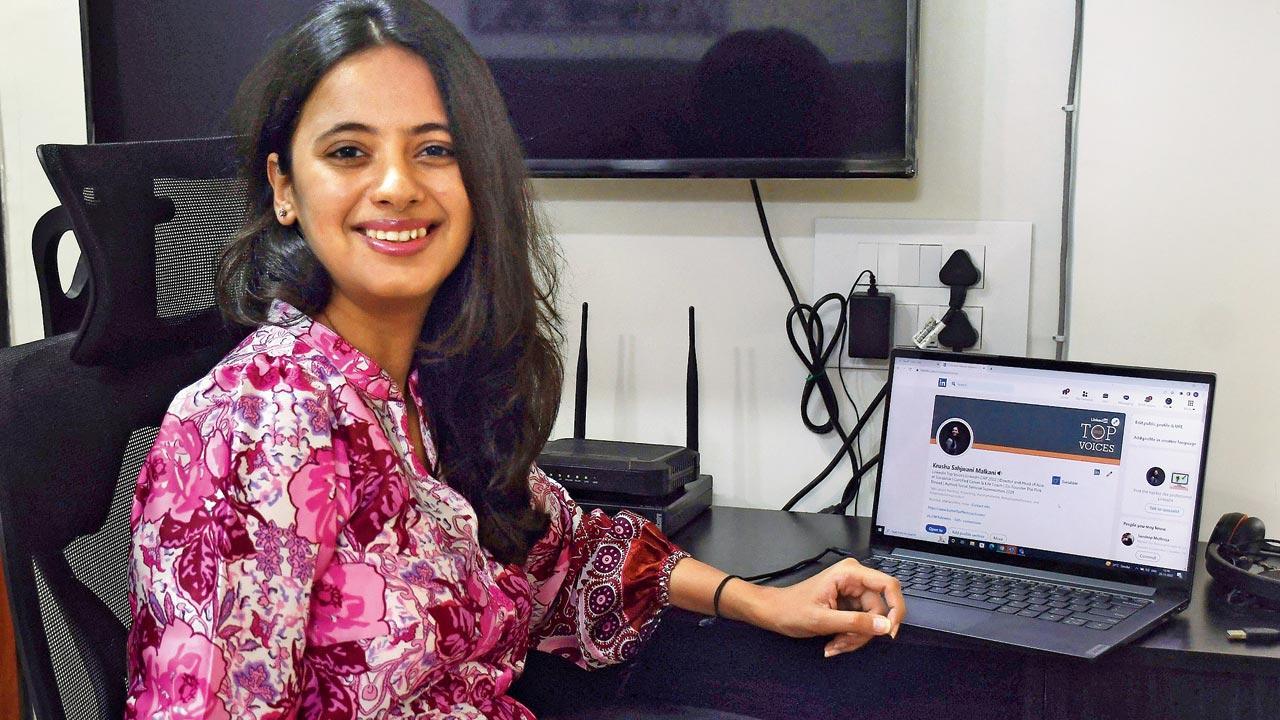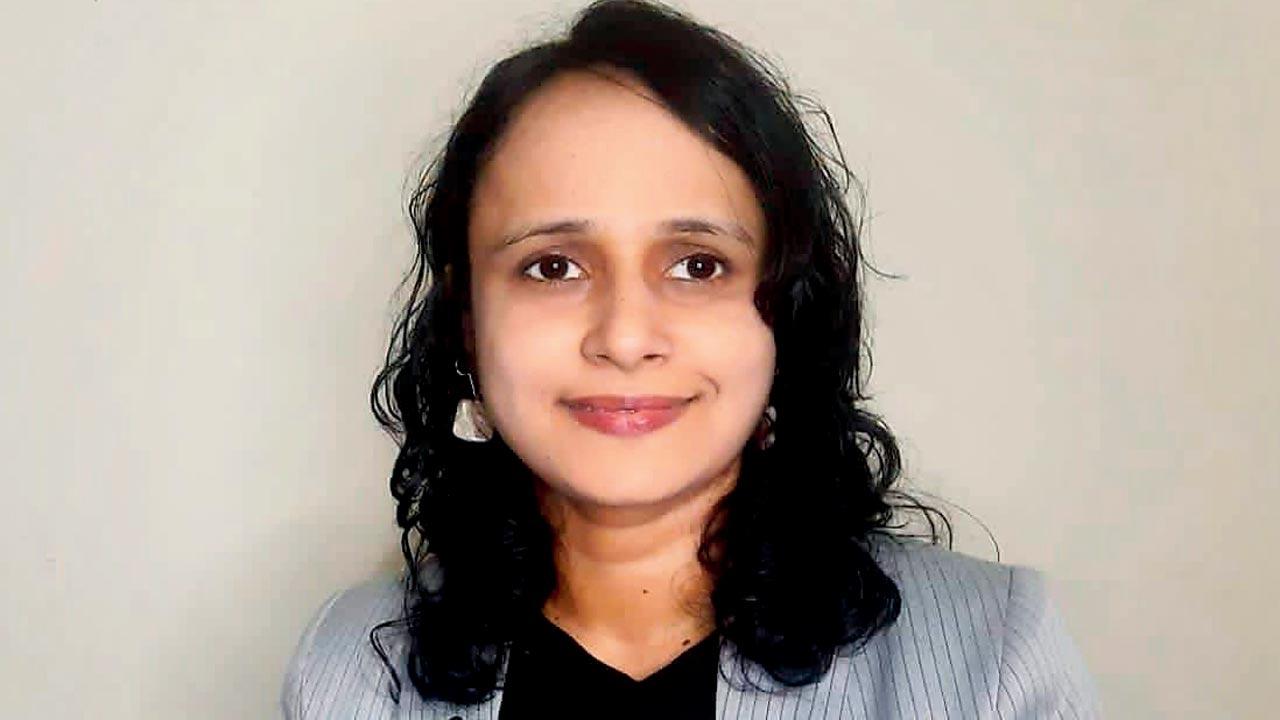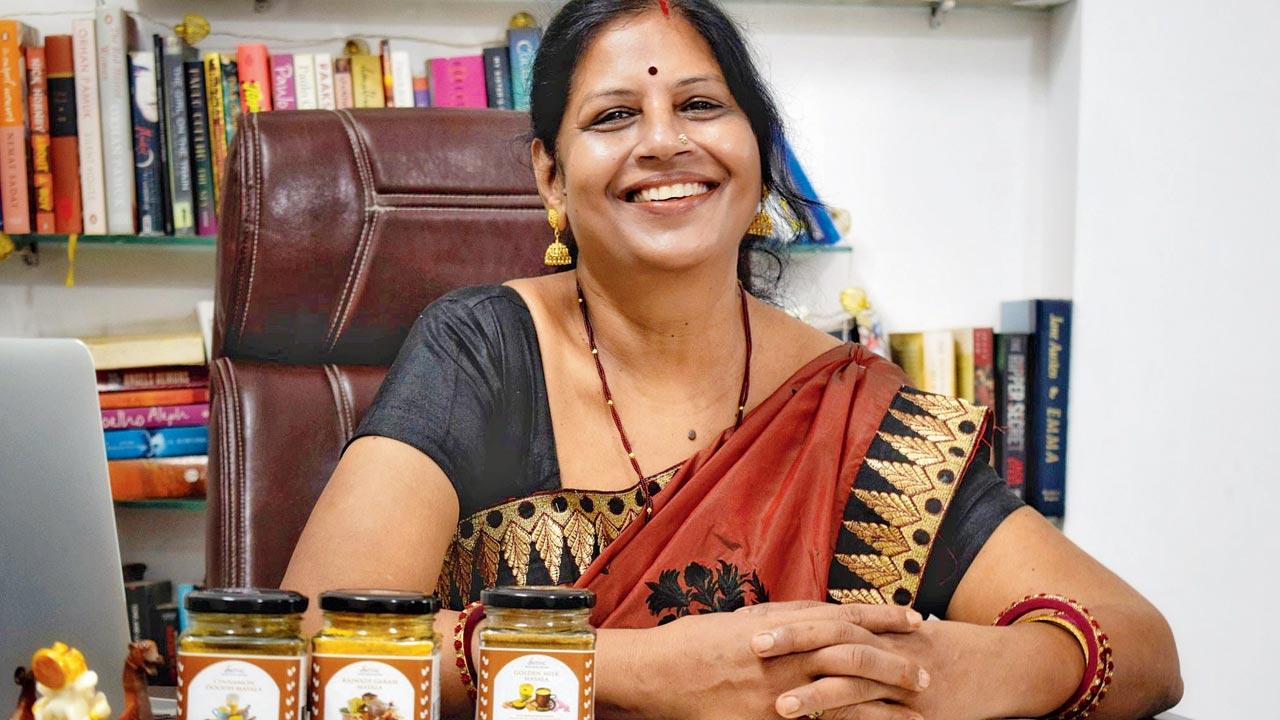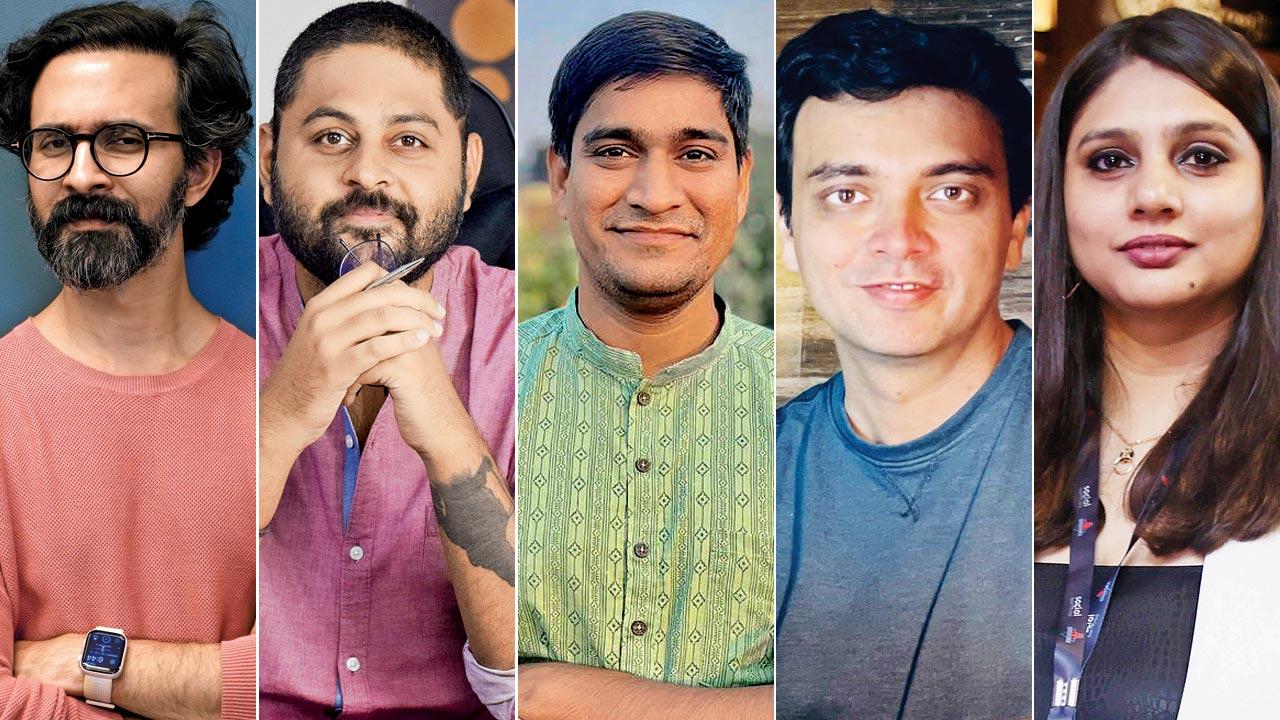LinkedIn is no longer about hiring or finding a job. It’s gone from a straight jacketed experience to a jazzed-up professional platform, which is about creating intelligent content that positions you as a brand. When did this happen?

Krusha Sahjwani Malkani, Asia head of an employee advocacy software Sociabble, who has 26,000 followers, says LinkedIn has evolved and is more about building a personal brand. Pic/Ashish Raje
It was late last year when Jamana Mahajan, a homemaker residing in Ujjain, Madhya Pradesh, launched Satvic Foods. On the launch day, she shared her story on LinkedIn, about how she got married in 1989, had her son a year later and dedicated herself to taking care of her family until the year 2021.
“In all these years, I have always wanted to do something of my own. Something that has my identity, my touch! My family has always supported me, but I wanted to stand on my own feet. One night before my 57th birthday, I was discussing one of my wishes with my son. One thing led to another and the next morning he went ahead and registered Satvic Foods,” read her post, which got over 22,000 reactions and almost 200 reposts.
 Gauri Das, senior HR professional
Gauri Das, senior HR professional
“Her story reached 2.5 million users and by the end of the day, it was covered in three major news publications,” says her son, author-writer Viraj, 30. Something which would demand a public relations team and significant marketing muscle was achieved, unintentionally though, through a post on LinkedIn. “There was a time when people would use LinkedIn to get jobs but these days, people share their personal stories,” he says, adding that many people have been vocal about their sexuality on the platform, a marker of good change he thinks about something that was for long considered a taboo in the professional space.
Like Viraj, other users too have noticed that the platform is now encouraging the sharing of life lessons. And it’s a relief for some that it doesn’t have to be in the format of Reels. Last month, a young mother shared a post about being fired by Twitter while she was on maternity leave. A father of two spoke about losing four members of his family to COVID, asking for a less stressful role at work, seeking counselling and trying to be a good single parent to his children. A young divorced woman talking about how she asks those who reach out to her to give more time to their marriage, unless it is toxic, and why this doesn’t make her hypocrite.
 Jamana Mahajan’s story of how she spent almost three decades as a homemaker before she decided to launch her own company reached 2.5 million users, and made it to three major news publications
Jamana Mahajan’s story of how she spent almost three decades as a homemaker before she decided to launch her own company reached 2.5 million users, and made it to three major news publications
While LinkedIn was once a platform where recruiters would post job openings and applicants would go looking for them, it has become way more and the numbers prove it—Q3 of 2021 saw 774 million users, and Q3 of 2022 has 850 million users. When it comes to India, says LinkedIn, the base grew by over 50 per cent with 96 million users.
“Today we get as much traffic from members of tier 2 and tier 3, as we get from tier 1 city professionals. This shift has been the result of our focused strategy on making LinkedIn accessible and approachable. In December 2021, we launched LinkedIn in Hindi, which opened it up to 600 million Hindi speaking creators,” says a spokesperson.
 Varun Duggirala, Viraj Mahajan, Ramveer Tanwar, Ajay Datta and Mrinil Mathur Rajwani
Varun Duggirala, Viraj Mahajan, Ramveer Tanwar, Ajay Datta and Mrinil Mathur Rajwani
“It is not just a place where people come for jobs. It is a place where people share knowledge, a place where professionals have equitable access to ideas, insights and inspiration that can unlock a world of opportunity through various mediums like pictures, text, articles, videos etc, operating in a safe and trustworthy space to express themselves,” says Ajay Datta, Head of Product, LinkedIn India, adding, “What differentiates us is the value that our members find in the time they spend on LinkedIn, where they gain new perspective, get information that helps them do their job well, and feel inspired about what’s ahead in the world of work.”
LinkedIn was always a place for professionals to progress their career, which hasn’t changed but what has changed is that it is has gone into a community space where people share values and experiences, and human skills are under the spotlight, says Andheri-based Varun Duggirala, an author and entrepreneur who co-founded The Glitch, a creative agency with which it executed campaigns like #FindTheBalance, which aimed at provoking honest conversations about the struggle to achieve a work-life balance while working from home during the pandemic. “LinkedIn has worked on its marketing and communications. It has gone from hiring and finding the next best job to showcasing the individual, tapping into not just their professional growth, but also the personal growth and looking at the individual’s journey from a humane lens,” adds Duggirala.
Agrees Breach Candy-based Krusha Sahjwani Malkani, who is Asia head of an employee advocacy software, Sociabble. “LinkedIn has evolved as a platform and is more about building a personal brand. It is not only your resume, but the content that you are creating that leads to jobs, and also side hustles.”
Malkani, 30, who has 26,000 followers, started experimenting with the platform during the lockdown. “I am a writer who showcased my work across a variety of platforms; I would fashion them content accordingly: While Instagram would work for lifestyle stories, LinkedIn would be about content that was more professional. But during the early days of the pandemic, I made an Instagram-like post for LinkedIn and it worked, so there was clearly a demand for it,” says Malkani. “It was during the two years when work and home merged that people really started embracing vulnerable posts. It is no longer about ‘I ace this job’ or ‘I earned that title’, I also want to read what a day of a working mother looks like.”
Talking about features, Malkani adds that the platform is becoming more creator-friendly. “Even in the last few weeks, it has come up with features like captions for videos. As a creator, if I put up a video, it automatically adds captions for me, which is something that a creator needs. Similarly, they are rolling out a feature that will allow you to schedule your posts as well.”
Creator is a word that emerged again and again during the search and writing of this story and it is something that LinkedIn is invested in greatly. “Content from professionals drives consumption and consumers end up spending more time on platforms. This is the precise reason why they have gone bullish on LinkedIn for creators programme,” says Mrinil Mathur Rajwani, managing partner at Social Samosa Network, which maps India’s social media developments.
In February this year, as part of the global $25 million investment in creators, LinkedIn launched Creator Accelerator Program in India, giving 200 individuals access to their 10-week incubator programme as well as additional resources and guidance from mentors to help them grow on the platform.
“It provided a roadmap for professionals to express themselves and build personal brands that would inspire other professionals to consume and create,” says Rajwani. When asked whether the platform, which was once popular among B2B marketers before they migrated to Instagram, is attracting them back, Rajwani says, “LinkedIn is still very relevant for B2B marketers. If they have moved to Instagram, it’s just for scale at a lower cost. The salience and precision LinkedIn drives is parallel to none. Of late, the platform has been offering great reach and engagement to professionals who are creating
content consistently.”
However, while some have been making efforts to become creators on this platform, some became one by accident. Like Ramveer Tanwar. A resident of Dadha, a village in Gautam Buddha Nagar district, Uttar Pradesh, Tanwar, who is an engineer by qualification, quit his full time job in 2018 to do what he wanted—protect the environment. He would use Facebook to spread awareness, until he was nudged by his friends to join LinkedIn in late 2019.
“I would make the same post on LinkedIn as I was making on Facebook, slowly it started getting good traction. Then in October last year, I posted a before and after photo of a pond that I was working on to improve and it reached about 3.5 million people. Some news channels reached out to me. They visited the pond and interviewed me. The next day, Sonu Sood featured me on his special programme on a news channel. The following Sunday, I was part of PM Narendra Modi’s Mann Ki Baat,” says Tanwar, who has about 35,000 followers on the platform. LinkedIn, he says, has helped him expand his work from one district to six districts. “From Gautam Buddha Nagar, I am now working in districts of Karnataka, Uttarakhand, Madhya Pradesh, Rajasthan as well Delhi,” he says. When asked how the platform has evolved, Tanwar says that he has no clue. “I only come to the platform to post and reply to the messages.”
Navi Mumbai-based Gauri Das, vice president and head of human resources at India Factoring and Finance Solutions Private Limited, is an active LinkedIn user and has as many as 52,442 followers.
It is about personal branding while staying authentic, says Das. “The platform has now touched every part of an employee’s life cycle, whether it is recruitment or development and learning. As HR personnel, we are also creating brand ambassadors. When people quit and move on, they talk about their experience of working at a company and in a way, they act as brand ambassadors.”
If you aren’t thinking about putting yourself there yet, Das recommends that you do. “It is not about bragging but telling people who you are at the core,” she says, adding that the only tip that works is being authentic.
The platform, however, has not been spared criticism. When it comes to drawbacks, Viraj Mahajan, who is actively involved in mentoring young writers, says that the platform is increasingly seeing people with barely any experience conducting paid webinars and there is no way to verify someone’s claims whether it is about their education or experience. “LinkedIn users have been complaining about reading fake stories. Plagiarism is rampant too and quite a few believe that LinkedIn is the new Facebook,” says Social Samosa’s Rajwani, adding, “All of this is true, but there are a lot of merits to the platform that beat these flaws.”
LinkedIn Dos and Don’ts
Dos
1. Be consistent, whether you want to post once or thrice a week
2. Content is king—find your niche and build your audience
3. Use audio-visual tools—polls, images, video, it will make your reach better
Don’ts
1. Don’t badmouth your employers, customers or vendors
2. Don’t touch anything that is controversial, HR personnel are watching you
3. Don’t copy and paste content, always credit the source
 Subscribe today by clicking the link and stay updated with the latest news!" Click here!
Subscribe today by clicking the link and stay updated with the latest news!" Click here!








